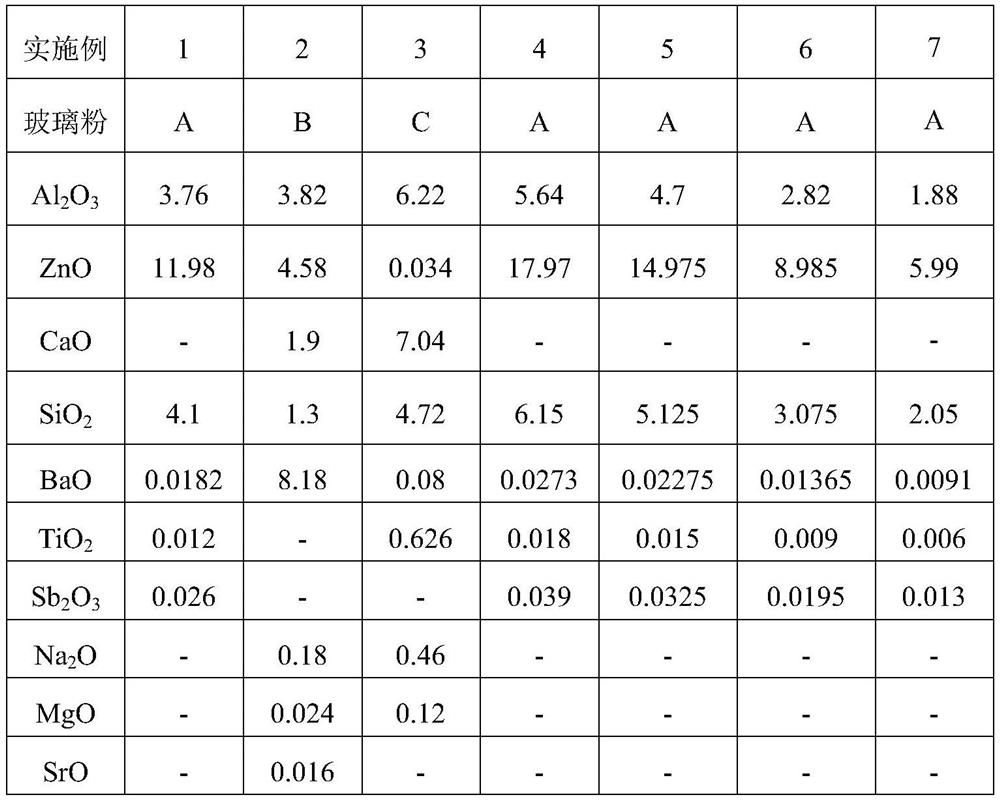Low-temperature co-fired ceramic material for millimeter wave antenna module and preparation method of low-temperature co-fired ceramic material
A low-temperature co-fired ceramic and millimeter-wave antenna technology, applied in the field of electronic ceramic materials and their manufacturing, can solve the problems of limited production and application, high process sintering temperature, large dielectric loss, etc., to ensure low temperature performance and operability. , Solve the effect of high sintering temperature and slightly poor compactness
- Summary
- Abstract
- Description
- Claims
- Application Information
AI Technical Summary
Problems solved by technology
Method used
Image
Examples
preparation example
[0048] In the following examples of the present invention, the types of low K value and low melting point glass powder involved, the content range value and actual addition amount of each raw material component in the glass powder are shown in Table 1 below.
[0049] According to the mass percentages recorded in the following table 1, the ingredients of the selected ingredients are respectively mixed, and the selected raw materials are blended, melted at high temperature into glass melt, and rolled into sheet glass after cooling, and then rolled into coarse glass through ceramics. Glass, and then through dry pulverization and jet pulverization, the coarse glass is made into low K value and low melting point glass powder of the required components, and is ready for use.
[0050] Components, mass percentages and properties of glass powders described in Table 1
[0051]
Embodiment 1
[0053] The method for preparing a low-temperature co-fired ceramic substrate for a millimeter-wave antenna module described in this embodiment includes the following steps:
[0054] (1) According to Mg 2 SiO 4 The content ratio of 80wt% and low K value and low melting point glass powder of 20wt%, take the Mg 2 SiO 4 and ZnO-SiO 2 -Al 2 O 3 The glass powder (A) is mixed, and water and zirconia balls are added in the ratio of the mass ratio of water: zirconia balls to 1:1.5:3, the diameter of the zirconia balls is controlled to be 1.5mm, and the ball milling speed is controlled to be 300r / min, carry out ball milling for 5 hours, and then dry at 180°C for 3 hours to complete drying, then sieve with an 80-mesh sieve to obtain formula powder, which is for later use;
[0055] (2) The obtained formula powder is made into slurry, and the slurry is made into a green ceramic tape by casting, and then the green ceramic tape is controlled to a heating rate of 3° C. / min in an air a...
Embodiment 2
[0057] The method for preparing a low-temperature co-fired ceramic substrate for a millimeter-wave antenna module described in this embodiment includes the following steps:
[0058] (1) According to Mg 2 SiO 4 The content ratio of 80wt% and low K value and low melting point glass powder of 20wt%, take the Mg 2 SiO 4 and BaO-ZnO-Al 2 O 3 -CaO(B) is mixed, and water and zirconia balls are added in the ratio of the mass ratio of water: zirconia balls to 1:1.5:3, the diameter of the zirconia balls is controlled to be 1.5mm, and the ball milling speed is controlled to be 320r / min, perform ball milling for 4 hours, and then dry at 150°C for 6 hours to complete drying, then sieve with an 80-mesh sieve to obtain formula powder for use;
[0059] (2) The obtained formula powder is made into slurry, and the slurry is made into a green ceramic tape by casting, and then the green ceramic tape is controlled to a heating rate of 3° C. / min in an air atmosphere, and the temperature is r...
PUM
| Property | Measurement | Unit |
|---|---|---|
| softening point | aaaaa | aaaaa |
| flexural strength | aaaaa | aaaaa |
| strength | aaaaa | aaaaa |
Abstract
Description
Claims
Application Information
 Login to View More
Login to View More - R&D
- Intellectual Property
- Life Sciences
- Materials
- Tech Scout
- Unparalleled Data Quality
- Higher Quality Content
- 60% Fewer Hallucinations
Browse by: Latest US Patents, China's latest patents, Technical Efficacy Thesaurus, Application Domain, Technology Topic, Popular Technical Reports.
© 2025 PatSnap. All rights reserved.Legal|Privacy policy|Modern Slavery Act Transparency Statement|Sitemap|About US| Contact US: help@patsnap.com



